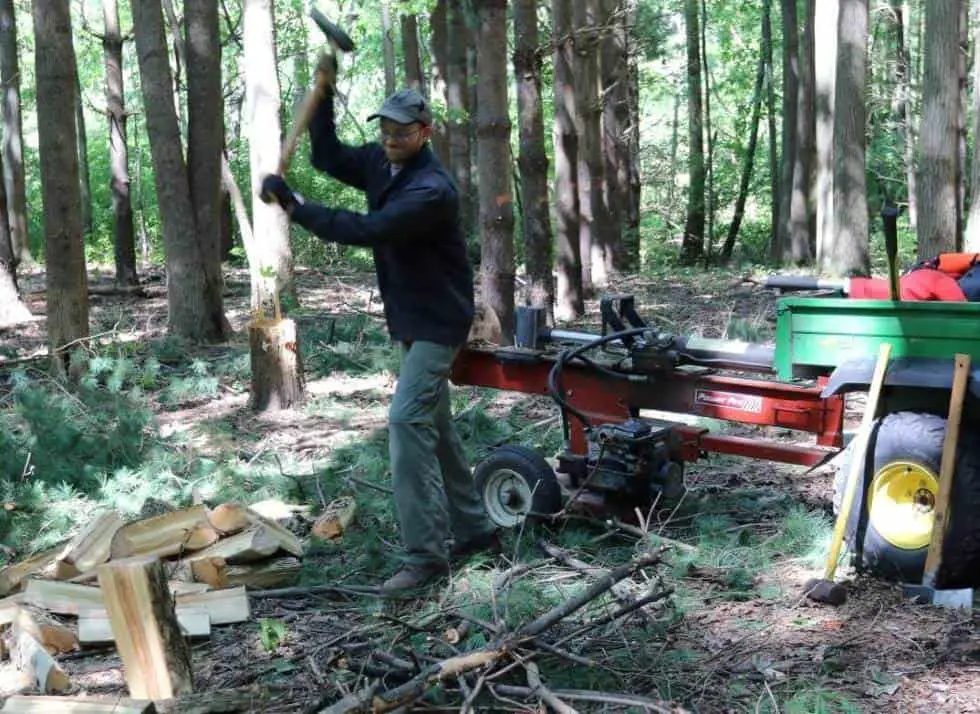
There are 5 main types of tools used to split logs into firewood pieces. They are as follows:
- Splitting Axes
- Splitting Mauls
- Splitting Wedges
- Log Splitters
- Hatchets
There is a time and a place for each of these tools, but there’s a good chance you’ll find one or two of them to be the most useful.
As a note, there are a few additional specialized tools, like kindling splitters. But the others just aren’t as common and are typically not as useful as the five classics listed above.
If you want to see a comparison of these tools up close, then check out this video I recorded that puts them all side-by-side:
In the following few sections, we’ll dig into axes, mauls, hatchets, wedges and log splitters. And by the end of this post, you’ll know the basics of each tool and when you should use them. Let’s get to it!
1. Splitting Axes
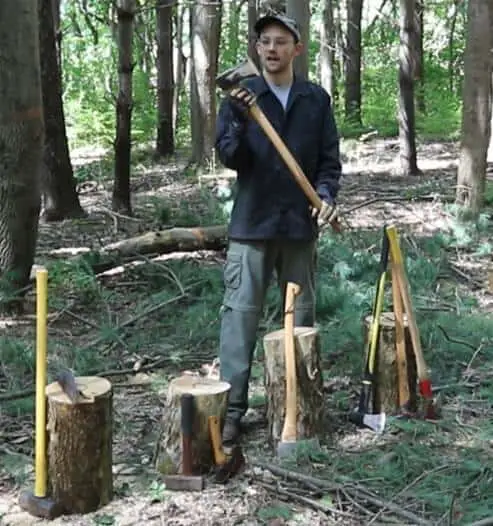
Axes are probably the best-known tools for splitting logs into firewood. There are many different types of axes, which vary in their shape, the weight of the head, and their intended use. We’re talking everything from battle axes to competition speed-axes.
But when it comes to splitting firewood, we’ll focus on the basic splitting axe
Notable Characteristics:
Splitting axes have a long straight handle, traditionally made from Hickory wood, which provides a balance of leverage and control. In addition, splitting axes have heavy steel heads, which usually weigh 3-6 pounds.
This is much heavier than smaller axe designs, forest axes for example, which are best for limbing branches and typically weigh 2-3 pounds total.
The shape of a splitting axe head also has a unique design. It is wedge-shaped and its blade is not particularly sharp, because it’s designed to force the wood apart and is not meant to actually slice the wood. Check out the photo below to see what I mean.
[insert photo of splitting axe head]
When to Use a Splitting Axe:
Honestly, you could probably do 90% of your firewood with a splitting axe. Splitting axes are durable, effective, and generally pretty cheap. Plus, splitting firewood with an axe is excellent exercise.
So, if you don’t mind doing things yourself, or if you only have a small amount of firewood, then it’s hard to beat an old fashioned splitting axe.
However, if you get stuck with a monster log that you just can’t split, you have some additional options to consider, starting with a splitting maul.
2. Splitting Mauls
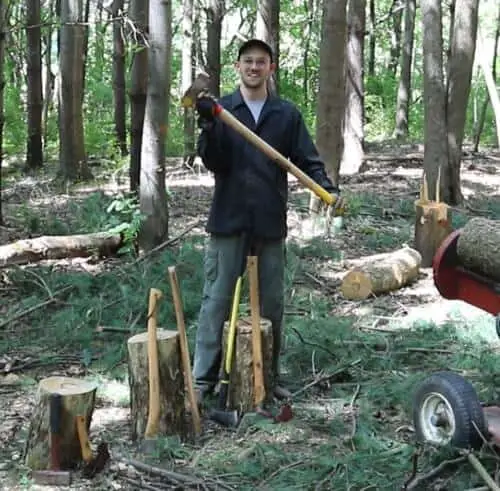
Splitting mauls and splitting axes are NOT the same, but they are closely related. A splitting maul is basically a bigger and heavier version of a splitting axe. There’s pros and cons to each, let’s dig deeper into their differences and common traits.
Notable Characteristics:
Like splitting axes, mauls have a long straight handle which is traditionally made from Hickory wood. Typically, a splitting maul will have a slightly longer handle, which gives them some additional power in the swing.
Mauls also have heavier axe heads, weighing in at 6-8 pounds, compared to the 3-6 pounds for splitting axes. Because mauls are heavier, you can’t use them for as long as splitting axes, because your arms will eventually wear-out.
The shape of a splitting maul head is also a bit different than splitting axes. Starting from the blade, the metal on the head curves outward (away from the center of the axe head), until it gets to the end of a base block.
The large block in the middle provides the weight of the axe head, and also creates an angle that forces wood away from itself, causing it to split. Have a look at the photo below to see this more clearly.
[insert photo of splitting maul head]
When to Use a Splitting Maul:
Use a splitting maul when a splitting axe isn’t quite enough power to split a particular log. Mauls work particularly well for splitting smaller piles of hardwoods, because the weight of the Maul is helpful for splitting dense woods, but it will wear you out after some use (time varies based on your level of buffness).
However, even with a heavy-duty maul, there’s going to be some logs that you can’t split. For those, you might try a splitting wedge.
3. Splitting Wedges
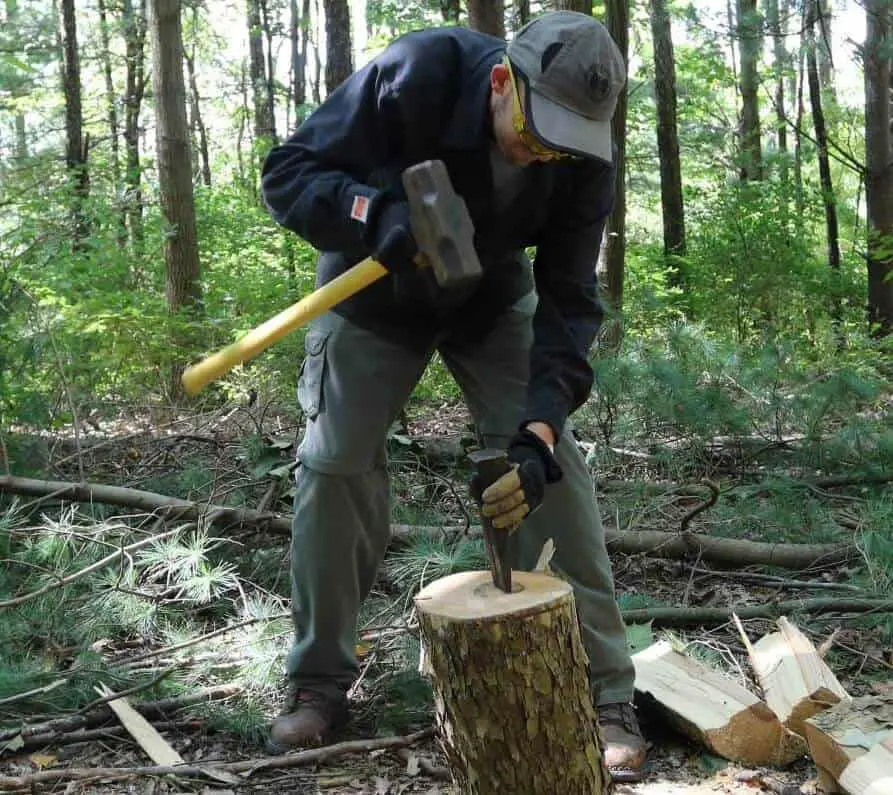
If you’ve never seen a splitting wedge before, it basically looks like a disembodied axe head. Here’s a photo of one:
[insert photo of splitting wedge]
A splitting wedge is unique because it can’t be used by itself. It has to be used in combination with a sledgehammer, or the blunt end (back side) of a single bladed axe.
In addition, you should really plan to always have at least 2 splitting wedges on hand. Here’s why:
- If the first wedge gets stuck, you have a spare to split it free
- When you’re dealing with really big logs, you can use both to finish the job
- If one gets damaged/broken, you can keep working with the second one
There’s probably even more reasons, but these are the key ones that come to mind. Splitting wedges are pretty cheap tools, so save yourself some trouble and make sure you’ve got two.
Notable Characteristics
Splitting wedges are made entirely out of steel, and if it’s a good quality one, it will be made from forged steel. This is an important distinction for splitting wedges, because the cheap versions that do not use forged steel are more likely to chip.
Chipping metal is a serious health risk, as the pieces can fly off and cause injury, especially if they hit someone in the eyes.
Other than the importance of the metal material, splitting wedges are very simple tools. And they are basically designed to be a splitting maul head, that you can drive into a piece of wood with a sledgehammer.
Nowadays, there’s actually two basic designs for a splitting wedge. The traditional wedge, which looks like an axe head (like in the picture above), and the “diamond-shaped” wedge. The diamond-shaped wedge has a flat base, and it spirals down to a fine-point, just like a screw.
The benefit of diamond-shaped wedges is that their fine-point makes it easier to get them initially started into the wood. However, I’ve only ever used the normal wedge design, and from what I hear, the diamond-shaped wedge isn’t really any better.
When to Use a Splitting Wedge
The interesting thing about wedges, is that they are basically the tool that exists between a splitting axe (or maul) and a log splitter. In other words, if you have a log that you can’t split with an axe or maul AND using a log splitter is not an option, then using a wedge is your best bet.
Learn how to split woods using a splitting wedge here.
As extra context, splitting wedges are probably the least often used splitting tool on this list. Nothing against them, they just aren’t as prevalent. Next, let’s turn our attention to log splitters.
4. Log Splitters
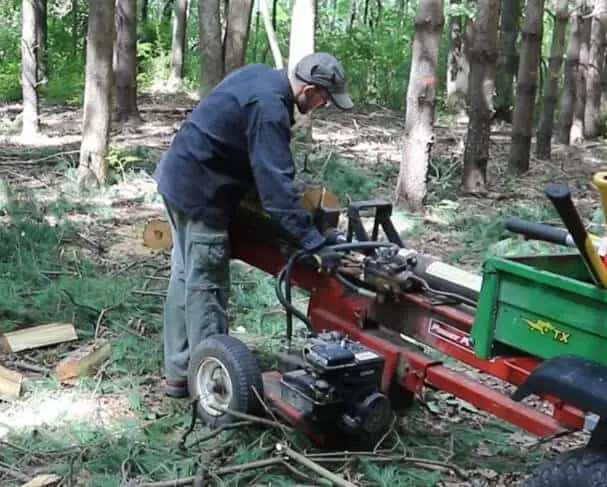
There are essentially three different types of log splitters out there.
- Gas log splitters
- Electric log splitters
- Manual (hydraulic) log splitters
Of these, gas log splitters are the most common. The technology for electric log splitters has been catching up, but as with anything where machine torque is important, it’s really tough for electric to compete with gas combustion engines.
On the other hand, manual log splitters (which use hydraulics and hand cranks to split logs) are interesting, but on a practical level I don’t see the appeal. For lighter wood, it will be faster to use a splitting axe, and depending on how much wood you split, I’m not sure a few heavy logs will justify buying a log splitter of any kind.
So, for the rest of this section, we’re going to focus on the dominate type of log splitter (e.g. gas-powered models).
Notable Characteristics
Gas log splitters use an engine-powered hydraulic shaft with a blade on the end, to split firewood. On the far end of a log splitter, there is also a metal block. So, a log splitter is pinching each log between the metal block and its hydraulic blade.
When comparing different models of gas log splitters, there are 3 big characteristics that come into play: tonnage, orientation, and cycle time.
Tonnage is the maximum amount of pressure that a log splitter can apply to split a log. Generally speaking, the higher the tonnage rating on a log splitter, the more power it has.
The second characteristic is orientation. Log splitters can either be horizontal, with the blade going side to side, or vertical, with the blade going up and down. Nowadays, most log splitters can actually transition to either orientation, and these types of splitters are listed as horizontal/vertical log splitters. This is an important thing to check, as it impacts how you can use the tool.
Lastly, the cycle time for a log splitter is the amount of time it takes to chop one piece of wood. The average cycle time for a log splitter is about 12 seconds. This is plenty of time for the machine to split a piece of wood while you get the next log ready. But don’t get super excited if you see a log splitter that has a 5 second cycle time. I don’t know about you, but I can’t even lift a log in 5 seconds.
When to Use A Log Splitter
There are basically two occasions on which you would use a log splitter over a splitting axe or wedge. You would use a log splitter for really tough-to-split hardwoods, that you just can’t cut with your manual tools.
A log splitter is also helpful if you have a LOT of firewood to chop and not much time to do it in. For example, if you have a firewood business, or if you split a winter’s supply of firewood for several families.
As you can imagine, using a gas-powered log splitter is quite fast, and unlike axes and wedges, some splitters can even split logs into 4 pieces at once (instead of the usual 2 pieces). The downside of gas log splitters is that they are quite expensive. Buying a new splitter can cost anywhere from several hundred, to over a thousand dollars.
For most people, it will be better to borrow a log splitter for a few hours to knock out those tough logs, or possibly to rent one if you can find a decent deal. If you’re just doing firewood for your own personal use, I would not recommend dropping the money to buy, fuel, and maintain a gas log splitter.
5. Hatchets

Okay, I admit, you’re not going to split full logs with a hatchet. However, hatchets are exceptionally good tools for chopping kindling after the full logs have been split, which is why I’ve included them here.
Here’s an interesting tidbit about hatchets that you may not have known: Although hatchets are often considered to be their own category, a hatchet is technically a small axe. The key distinction between a hatchet and other axes, is that a hatchet is designed to be used with one hand.
Because hatchets are smaller and lighter, they are easier to control. And they also have very narrow steel heads, which allows the user to make finer cuts of wood.
Notable Characteristics
A hatchet has a narrow and relatively lightweight head, which is typically made of steel. The handle of a hatchet is short, usually around 8-14 inches long. Traditionally, the handles were made of straight-grained hardwoods, like Hickory. But today, they are also made of plastics and composite materials.
Hatchets are popular tools for garden work and camping, and they come in a variety of designs. Some have straight handles, and others have inward curving handles, allowing the hatchet to be more easily held with one hand. In the below photo, you can see an example of Gransfors Bruks Hand Hatchet.
When to Use a Hatchet
If you’re looking to split full logs, then you’re not going to use a hatchet. You’re going to use one of the first four tools mentioned above. However, no firewood supply is complete without a pile of kindling to help get the fire going.
So, for splitting logs, use the four tools above. For splitting kindling, a hatchet is way better, due to the shape of the blade and the ease of control which comes from less weight and a smaller handle.
Related Questions
What is the Best Tool for Splitting Logs
The best tool for splitting logs is a splitting axe. Splitting axes are lighter and more versatile than mauls. A splitting axe is also faster to use than a splitting wedge, and more affordable than a log splitter. Each person may prefer a different tool, but generally a splitting axe works best.
What is the Difference Between an Axe and Maul?
A splitting maul is basically a bigger and heavier version of a splitting axe. Splitting mauls typically have a 6-8 pound axe head, whereas a splitting axe has a 3-6 pound axe head. Mauls are preferred for splitting denser hardwoods, and splitting axes are better for carrying or extended use.
